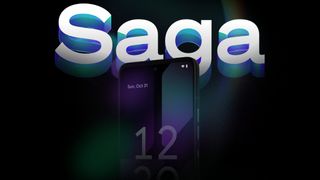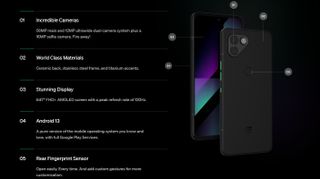The Essential Phone’s spiritual successor is a high-end handset with old-school features
The Saga has top-tier power but is oddly old-fashioned

Most high-end smartphones aim to do broadly the same things – offering tons of power, top-tier screens, and excellent cameras; paired with a sleek design. But the new Saga phone does things a bit differently.
This handset is made by OSOM – a company made up of people who worked on the Essential Phone – and it’s been created for Solana Mobile, which is a cryptocurrency company. That makes for an unusual pedigree, and goes some way to explaining the specs of this phone, which have recently been revealed.
They include a top-end Snapdragon 8 Plus Gen 1 chipset, 12GB of RAM, 512GB of storage, a microSD card slot, a 6.67-inch FHD+ 120Hz OLED screen, a 4,110mAh battery, a 50MP main camera, a 12MP ultra-wide one, and a 16MP selfie snapper. The Saga also runs Android 13, and has an IP68 rating, meaning it’s resistant to water and dust ingress.
Evidently, there’s no shortage of power here and there’s loads of storage, but the screen is lower resolution than most top flagships (which tend to have QHD+ displays), the camera system is low on lenses, and the battery sounds rather small. Unusually though, it has a microSD card slot, which is a rare sight these days on expensive handsets.

Then there’s the design – the Saga phone has a ceramic back, a stainless-steel frame and titanium accents, which along with its IP68 rating makes for a premium build, yet the bezels above and below the display aren’t small, leaving it looking mid-range at best.
If this was a mid-range phone it would be a bargain for some of the specs on offer, but it’s not – the Saga is priced at $1000 (around £880 / AU$1,590). That puts it in line with the starting price of the iPhone 14 Pro – though in fairness you’ll pay a lot more than that for 512GB of storage with Apple’s phone.
Still, this is a high-end phone with an unusual mix of specs, which on paper seem a bit unbalanced. But then the Saga isn’t really aimed at mainstream audiences, as it also has all sorts of crypto credentials, with web3 features aimed at “defi pros, NFT collectors, and the most demanding crypto enthusiasts.”
Get daily insight, inspiration and deals in your inbox
Get the hottest deals available in your inbox plus news, reviews, opinion, analysis and more from the TechRadar team.
So its intended audience likely has different priorities than typical buyers of an iPhone 14 Pro or Samsung Galaxy S22 Plus. Which isn’t to say they wouldn’t appreciate more cameras or a bigger battery, but they might consider this an acceptable compromise to get more specialist features at this price.
If you fall into that camp – and live in the US, UK, Canada or the EU - you can pre-order the Saga now, by putting down a $100 deposit, but the phone won’t ship until early 2023.
Analysis: an odd mix of old and new
The Saga’s microSD card slot and modest battery capacity both make it sound a bit like a phone from the past – while its crypto features and chipset point more towards the future.
But there’s another old-fashioned feature here too – a rear fingerprint sensor. The vast majority of fingerprint sensors on high-end phones now are built into the screen, but the choice to put it on the rear of the Saga phone was probably more than just a cost-cutting measure.
In-screen fingerprint sensors still haven’t been perfected – they’re often slower than more conventional sensors, and can be prone to misreads. So a capacitive fingerprint sensor on the back can in some ways be better.
Plus, this sensor has had some thought put into it, as it supports custom gestures. So – much like a microSD card slot - it’s old-fashioned, but arguably in a good way, and is something many of the best phones could learn from.
James is a freelance phones, tablets and wearables writer and sub-editor at TechRadar. He has a love for everything ‘smart’, from watches to lights, and can often be found arguing with AI assistants or drowning in the latest apps. James also contributes to 3G.co.uk, 4G.co.uk and 5G.co.uk and has written for T3, Digital Camera World, Clarity Media and others, with work on the web, in print and on TV.

